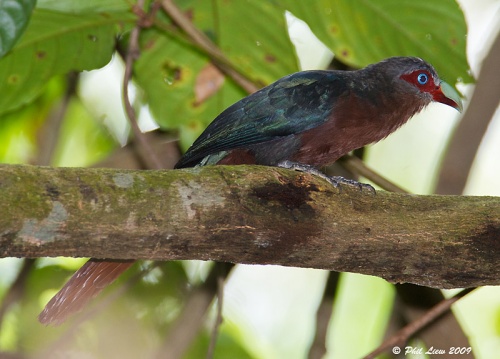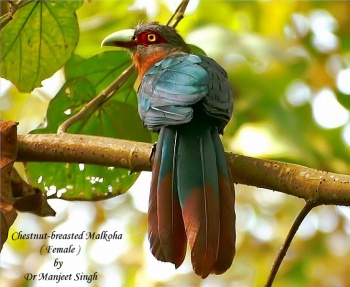- Phaenicophaeus curvirostris
Identification
Size:-35cm including tail
Has entirely chestnut underparts and a lack of white tip to tail feathers. Upperparts dark iridescent green, including most of the uppertail. Has broad chestnut terminal band on upper tail. Sides of entire tail narrowly marked chestnut.
Orbital skin red.
Male - Pale blue eyes
Female-Eyes Golden to yellowish white
Distribution
Southeast Asia: found in Tenasserim (Myanmar) and the Malay Peninsula south to Greater Sundas, Java, Bali, Borneo and Palawan (Philippines).
Taxonomy
Mentawai Malkoha was formerly considered a part of Chestnut-breasted Malkoha.
Subspecies
Clements recognizes these subspecies[1]:
- P. c. singularis:
- Southern Myanmar to southern Thailand, Malay Peninsula and Sumatra
- P. c. curvirostris:
- Western and central Java
- P. c. deningeri:
- Eastern Java and Bali
- P. c. microrhinus:
- Borneo and Bangka Island
- P. c. harringtoni:
- Southern Philippines (Palawan, Balabac, Busuanga, Culion, Calauit)
An additional subspecies erythrognathus is generally considered a synonym of subspecies singularis[3].
Habitat
Mangroves (on Pulau Langkawi only), forests, forests edges, plantations and wooded gardens.
Behaviour
Usually found in pairs in the Middle storey. Sometimes forages low in dense scrub. Generally unobtrusive, perching for long periods in the foliage.
References
- Clements, J. F., P. C. Rasmussen, T. S. Schulenberg, M. J. Iliff, T. A. Fredericks, J. A. Gerbracht, D. Lepage, A. Spencer, S. M. Billerman, B. L. Sullivan, M. Smith, and C. L. Wood. 2024. The eBird/Clements checklist of Birds of the World: v2024. Downloaded from https://www.birds.cornell.edu/clementschecklist/download/
- Gill, F, D Donsker, and P Rasmussen (Eds). 2024. IOC World Bird List (v 14.2). Doi 10.14344/IOC.ML.14.2. http://www.worldbirdnames.org/
- Avibase
Recommended Citation
- BirdForum Opus contributors. (2025) Chestnut-breasted Malkoha. In: BirdForum, the forum for wild birds and birding. Retrieved 17 May 2025 from https://www.birdforum.net/opus/Chestnut-breasted_Malkoha
External Links
GSearch checked for 2020 platform.





